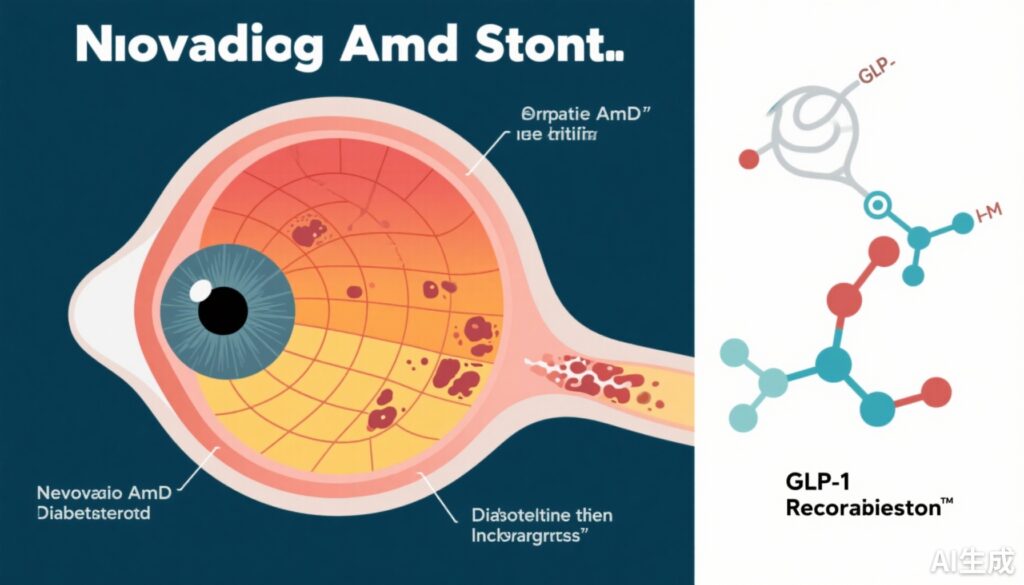Highlights
- Use of GLP-1 receptor agonists (GLP-1 RAs) in diabetic patients is associated with a doubled risk of incident neovascular age-related macular degeneration (nAMD).
- GLP-1 RA treatment is linked to a modestly elevated risk of incident diabetic retinopathy (DR), though it might reduce sight-threatening DR complications and blindness.
- Semaglutide, a widely used GLP-1 RA, shows a modest but consistent association with increased risk of nonarteritic anterior ischemic optic neuropathy (NAION), especially with prolonged use.
- These ocular risks highlight the necessity for routine ophthalmic screening and risk-benefit assessment in patients on GLP-1 RAs.
Background
Glucagon-like peptide-1 receptor agonists (GLP-1 RAs) are cornerstone agents in the management of type 2 diabetes mellitus (T2DM) and obesity due to their efficacy in glycemic control and weight reduction. However, the retina and optic nerve are vulnerable to diabetes-related microvascular and ischemic complications. Neovascular age-related macular degeneration (nAMD), diabetic retinopathy (DR), and nonarteritic anterior ischemic optic neuropathy (NAION) represent key sight-threatening conditions. Despite extensive use, the long-term ocular safety profile of GLP-1 RAs remains incompletely defined, posing challenges for clinicians balancing systemic benefits against potential vision risks.
Key Content
1. GLP-1 RAs and Neovascular Age-Related Macular Degeneration (nAMD)
A landmark population-based retrospective cohort study conducted in Ontario, Canada (Shor et al., 2025), studied 139,002 diabetic patients aged ≥66 years with a median 3-year follow-up. After propensity score matching and adjusting for systemic comorbidities and socioeconomic variables, GLP-1 RA exposure (>6 months) was associated with a significant increase in nAMD incidence (0.2% vs 0.1%; adjusted hazard ratio [HR], 2.21; 95% confidence interval [CI], 1.65–2.96). This robust finding highlights a twofold elevated risk of nAMD, a severe sight-threatening condition characterized by choroidal neovascularization and retinal hemorrhages.
2. GLP-1 RAs, Diabetic Retinopathy (DR), and Sight-Threatening Complications
Ramsey et al. (2025) analyzed 185,066 adults with T2DM using the TriNetX database, matched by propensity scores, with a 2-year follow-up. GLP-1 RA users exhibited a modestly increased risk for incident DR (HR 1.07, 95% CI 1.03–1.11). Importantly, in patients with preexisting DR, GLP-1 RA use was not linked to increased progression to proliferative DR or diabetic macular edema but was associated with fewer occurrences of vitreous hemorrhage (HR 0.74), neovascular glaucoma (HR 0.78), and blindness (HR 0.77). These results suggest a complex interplay where GLP-1 RA use may slightly increase DR onset risk but reduce severe complications, potentially due to improved systemic metabolic control or anti-inflammatory effects.
Additional data from other longitudinal cohorts (including those on dialysis and kidney transplant recipients) reiterate that GLP-1 RAs may slightly increase diabetic retinopathy risk but overall provide survival and systemic benefits.
3. Semaglutide and Nonarteritic Anterior Ischemic Optic Neuropathy (NAION)
NAION is an acute ischemic optic neuropathy causing sudden and irreversible vision loss. Multiple large-scale retrospective studies, supplemented by meta-analyses (Cai et al., 2025; and Danish-Norwegian registries), investigated the association between semaglutide and NAION. Across 37 million T2DM patients, new semaglutide users (n~810,000) had an incidence rate of NAION of 14.5 per 100,000 person-years. The hazard ratios compared to other antidiabetic drugs were variable but pointed to a modest increase: meta-analysis of self-controlled case series found an incidence rate ratio (IRR) of 1.32 (95% CI, 1.14–1.54). Danish-Norwegian registry data showed a pooled HR of 2.81 (95% CI, 1.67–4.75) compared with sodium-glucose cotransporter-2 inhibitors (SGLT2is). Clinical risk factors exacerbating NAION risk included older age, male sex, prolonged diabetes duration, higher HbA1c, diabetic retinopathy, and obesity.
Some studies also indicated that GLP-1 RAs as a drug class may modestly increase NAION risk, though absolute incidence remains low. Notably, certain observational studies reported no significant NAION risk with GLP-1 RA use, indicating heterogeneity and the need for cautious interpretation.
4. Additional Ocular Complications and Protective Effects
Emerging evidence suggests GLP-1 RAs may reduce the risk of uveitis—a primarily inflammatory ocular condition—highlighting possible anti-inflammatory properties beyond glycemic effects (JAMA Ophthalmology 2025). Conversely, calcium channel blockers were associated with increased risk of diabetic macular edema (DME), whereas GLP-1 RAs and fenofibrates showed protective effects against DME development.
Expert Commentary
GLP-1 RAs are transformative in managing T2DM and obesity, reducing cardiovascular events and improving survival, including in renal transplant and dialysis populations. However, the ocular safety profile necessitates vigilance, especially given the observed twofold increased risk of nAMD, modest DR risk elevation, and modest NAION risk primarily driven by semaglutide.
Mechanistically, GLP-1 receptors are expressed in retinal tissues and may modulate retinal microvascular function and inflammation. GLP-1 RAs could potentially exacerbate or ameliorate retinal ischemia-related pathologies depending on patient-specific factors. The increased nAMD risk may relate to angiogenic or inflammatory pathways influenced by GLP-1 pathway modulation, but precise biological underpinnings remain to be elucidated.
Clinical guidelines currently do not differentiate ocular screening protocols for GLP-1 RA users; these findings argue for enhanced ophthalmic monitoring for early detection of nAMD and DR. Patients on semaglutide, particularly with comorbid hypertension or advanced diabetes, may require closer optic nerve evaluation for NAION signs.
Real-world data reflect the complexity of balancing systemic benefits against rare but serious ocular risks. Causality is not established due to retrospective designs and potential confounding. Prospective studies and mechanistic research are urgently needed.
Conclusion
Systemic use of GLP-1 receptor agonists in diabetes care confers a twofold increased risk of neovascular AMD and a modestly elevated risk of diabetic retinopathy onset, alongside a small but significant increased risk of NAION with semaglutide use. These findings support the necessity for regular, comprehensive ophthalmic screening when initiating or maintaining GLP-1 RA therapy, especially in high-risk patients. Enhanced understanding of the pathophysiology linking GLP-1 signaling and retinal/neural ischemic events could lead to optimized therapeutic strategies that maximize metabolic benefits while minimizing ocular risks.
Future research priorities include elucidation of molecular mechanisms, identification of patient subgroups at greatest risk, randomized controlled trials to verify associative findings, and development of evidence-based ocular safety guidelines in GLP-1 RA treatment contexts.
References
- Shor R, Mihalache A, Noori A, et al. Glucagon-Like Peptide-1 Receptor Agonists and Risk of Neovascular Age-Related Macular Degeneration. JAMA Ophthalmol. 2025;143(7):587-594. doi:10.1001/jamaophthalmol.2025.1455 IF: 9.2 Q1 . PMID: 40471562 IF: 9.2 Q1 .
- Ramsey DJ, Makwana B, Dani SS, et al. GLP-1 Receptor Agonists and Sight-Threatening Ophthalmic Complications in Patients With Type 2 Diabetes. JAMA Netw Open. 2025;8(8):e2526321. doi:10.1001/jamanetworkopen.2025.26321 IF: 9.7 Q1 . PMID: 40788647 IF: 9.7 Q1 .
- Cai CX, Hribar M, Baxter S, et al. Semaglutide and Nonarteritic Anterior Ischemic Optic Neuropathy. JAMA Ophthalmol. 2025;143(4):304-314. doi:10.1001/jamaophthalmol.2024.6555 IF: 9.2 Q1 . PMID: 39976940 IF: 9.2 Q1 .
- GLP-1RA and the risk of non-arteritic anterior ischaemic optic neuropathy in patients with type 2 diabetes: A population-based study. Diabetes Obes Metab. 2025 Oct 17. PMID:41104517 IF: 5.7 Q1 .
- Association between Semaglutide and Nonarteritic Anterior Ischemic Optic Neuropathy: A Multinational Population-Based Study.Ophthalmology. 2025 Apr;132(4):381-388. PMID:39491755 IF: 9.5 Q1 .



